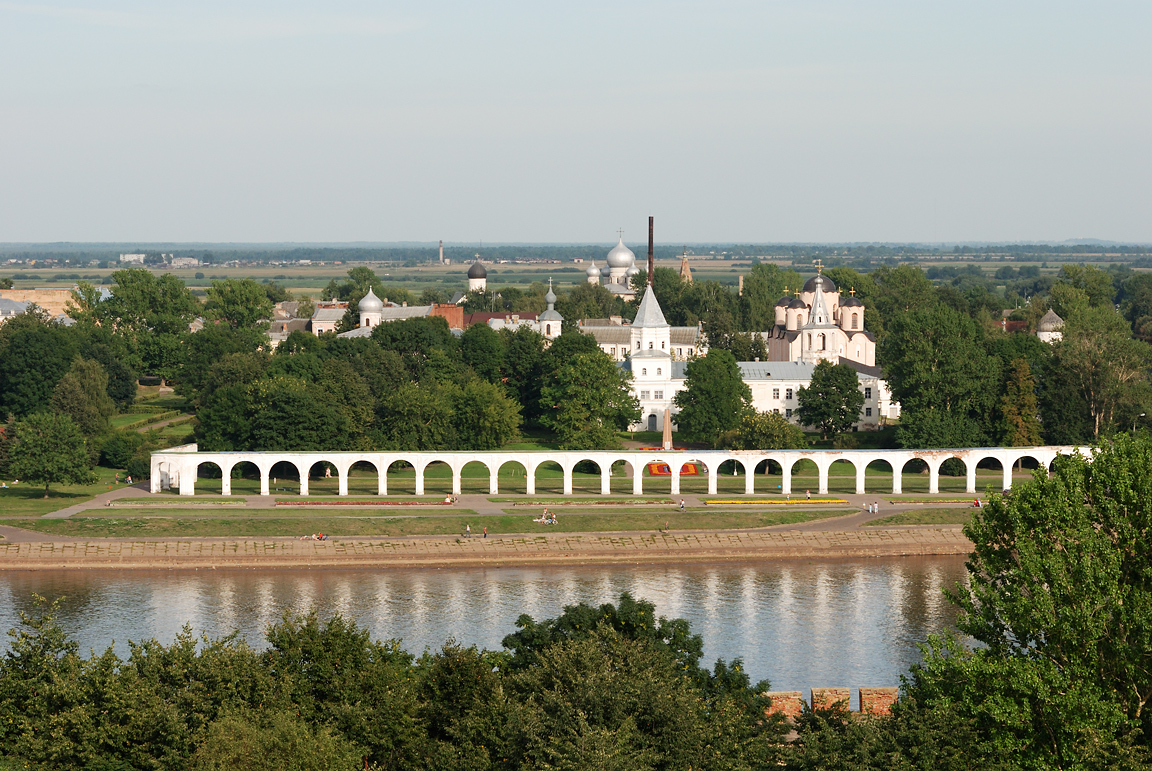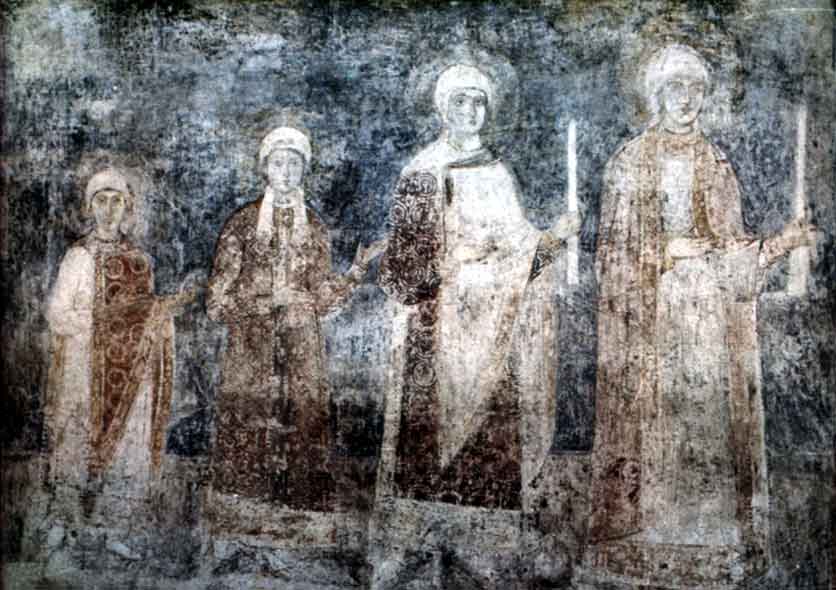|
Yaroslav's Court
Yaroslav's Court (, ''Yaroslavovo Dvorishche'') was the princely compound in the city of Novgorod the Great. Today it is roughly the area around the Trade Mart, the St. Nicholas Cathedral, the Church of St. Procopius, and the Church of the Myrrh-bearing Women. The Trade Mart renovated and heavily modified in the sixteenth and seventeenth centuries, is all that is left of the princely palace itself. The prince also had a compound called the Riurik's Court (''Riurikovo Gorodishche'') south of the marketside of the city. Yaroslav's Court is named after Yaroslav the Wise who, while prince of Novgorod in 988–1015, built a palace there. The Novgorodian veche A ''veche'' was a popular assembly during the Middle Ages. The ''veche'' is mentioned during the times of Kievan Rus' and it later became a powerful institution in Russian cities such as Veliky Novgorod, Novgorod and Pskov, where the ''veche'' a ... often met in front of Yaroslav's Court and in 1224 several pagan sorcerers w ... [...More Info...] [...Related Items...] OR: [Wikipedia] [Google] [Baidu] |
Novgorod The Great
Veliky Novgorod ( ; , ; ), also known simply as Novgorod (), is the largest city and administrative centre of Novgorod Oblast, Russia. It is one of the oldest cities in Russia, being first mentioned in the 9th century. The city lies along the Volkhov River just downstream from its outflow from Lake Ilmen and is situated on the M10 federal highway connecting Moscow and Saint Petersburg. UNESCO recognized Novgorod as a World Heritage Site in 1992. The city has a population of At its peak during the 14th century, the city was the capital of the Novgorod Republic and was one of Europe's largest cities. The "Великий" part was added to the city's name in 1999. Climate Veliky Novgorod has a humid continental climate (Köppen ''Dfb''). The city has warm summers with temperatures reaching over 30 °C (86 °F) and relatively cold winters with frequent snowfall. The lowest air temperature ever recorded is -45 °C (-49 °F). The warmest month is July with a daily ... [...More Info...] [...Related Items...] OR: [Wikipedia] [Google] [Baidu] |
Saint Nicholas Cathedral, Novgorod
Saint Nicholas Cathedral (, ''Nikolo-Dvorishchensky Cathedral'', ''Saint Nicholas Cathedral on Yaroslav's Court''), founded by Mstislav the Great in 1113 and consecrated in 1136, is the oldest surviving building in the central part of Veliky Novgorod after the Saint Sophia Cathedral. The Saint Nicholas Cathedral is on the World Heritage list as a part of object 604 Historic Monuments of Novgorod and Surroundings. The cathedral was designated by the Russian government as an architectural monument of federal significance (#5310046007). History The cathedral is located outside of the kremlin walls, on the right bank of the Volkhov River at the Yaroslav's Court. It was founded by Mstislav, the prince of Novgorod, in 1113, however, the construction took over twenty years, and the cathedral was consecrated in 1136, when Novgorod was already a republic. Presumably, the cathedral was supposed to serve the residence of the prince located at the Yaroslav's Court and was connected to the r ... [...More Info...] [...Related Items...] OR: [Wikipedia] [Google] [Baidu] |
Yaroslav The Wise
Yaroslav I Vladimirovich ( 978 – 20 February 1054), better known as Yaroslav the Wise, was Grand Prince of Kiev from 1019 until his death in 1054. He was also earlier Prince of Novgorod from 1010 to 1034 and Prince of Rostov from 987 to 1010, uniting the principalities for a time. Yaroslav's baptismal name was George after Saint George. Yaroslav was a son of Vladimir the Great and Rogneda of Polotsk. Yaroslav ruled the northern lands around Rostov before being transferred to Novgorod in 1010. He had a strained relationship with his father and refused to pay tribute to Kiev in 1014. Following Vladimir's death in 1015, Yaroslav waged a complicated war for the Kievan throne against his half-brother Sviatopolk, ultimately emerging victorious in 1019. As the Grand Prince of Kiev, Yaroslav focused on foreign policy, forming alliances with Scandinavian countries and weakening Byzantine Empire, Byzantine influence on Kiev. He successfully captured the area around present-day Tartu ... [...More Info...] [...Related Items...] OR: [Wikipedia] [Google] [Baidu] |
Veche
A ''veche'' was a popular assembly during the Middle Ages. The ''veche'' is mentioned during the times of Kievan Rus' and it later became a powerful institution in Russian cities such as Veliky Novgorod, Novgorod and Pskov, where the ''veche'' acquired great prominence and was broadly similar to the Norse Thing (assembly)#Viking and medieval society, ''thing'' or the Swiss ''Landsgemeinde''. The last ''veche'' meeting was held in Pskov before the institution was abolished in 1510. Etymology The word ''veche'' is a transliteration of the Russian (), which is in turn inherited from Proto-Slavic language, Proto-Slavic (), which is also represented in the word ''soviet (council), soviet'', both ultimately deriving from the Proto-Slavic verbal stem of ). History Origins Procopius, Procopius of Caesarea mentioned Slavs gathering in popular assemblies in the 6th century: The ''veche'' is thought to have originated in the tribal assemblies of Eastern Europe, thus predating the stat ... [...More Info...] [...Related Items...] OR: [Wikipedia] [Google] [Baidu] |
Vsevolod Of Pskov
Vsevolod Mstislavich Monomakh (), the patron saint of the city of Pskov, ruled as Prince of Novgorod in 1117–32, Prince of Pereyaslavl (1132) and Prince of Pskov in 1137–38. Early life The eldest son of Mstislav the Great and Christina Ingesdotter of Sweden, Vsevolod was born in Novgorod during his father's reign as prince there (1088–1093, 1095–1117) and given the baptismal name Gabriel, or Gavriil. His maternal grandfather was King Inge the Elder of Sweden. The date of his birth is unknown, although the idea has been advanced that the event was commemorated by the Annunciation Church in the Marketplace, founded by Mstislav in 1103. He was enthroned as Prince of Novgorod after his father Mstislav Vladimirovich became Grand Prince of Kiev in 1117 and ruled Novgorod, with some interruption, until he was ousted by the Novgorodians in 1136. He was married to a Chernigovian princess in Novgorod in 1123 and his son, Ivan, was born there (he died in 1128). In 1123, Vs ... [...More Info...] [...Related Items...] OR: [Wikipedia] [Google] [Baidu] |
Saint Sophia Cathedral In Novgorod
The Cathedral of Saint Sophia, the Holy Wisdom of God () in Veliky Novgorod, Russia, is the cathedral church of the Metropolitan of Novgorod and the mother church of the Novgorodian Eparchy. History The 38-metre-high, five-domed, stone cathedral was built by Vladimir of Novgorod and Bishop Luka Zhidiata between 1045 and 1050 to replace an oaken cathedral built by Bishop Ioakim Korsunianin in the late tenth century. This makes it the oldest church building in Russia outside the Caucasus ( Tkhaba-Yerdy in Ingushetia dates from before the 8th century) and the oldest building of any kind still in use in the country, with the exception of the Arkhyz and Shoana churches. It was consecrated by Bishop Luka Zhidiata (1035–1060) on September 14, in 1050 or 1052, the feast of the Exaltation of the Cross. (A fresco just inside the south entrance depicts Sts. Constantine and Helena, who found the true cross in the fourth century; it is one of the oldest works of art in the ca ... [...More Info...] [...Related Items...] OR: [Wikipedia] [Google] [Baidu] |
Novgorod Republic
The Novgorod Republic () was a medieval state that existed from the 12th to 15th centuries in northern Russia, stretching from the Gulf of Finland in the west to the northern Ural Mountains in the east. Its capital was the city of Novgorod. The republic prospered as the easternmost trading post of the Hanseatic League, and its people were much influenced by the culture of the Byzantines, with the Novgorod school of icon painting producing many fine works. Novgorod won its independence in 1136 after the Novgorodians deposed their prince and the Novgorod ''veche'' began to elect and dismiss princes at its own will. The ''veche'' also elected the '' posadnik'', who was the chief executive of the city, and the archbishop of Novgorod, subject to approval by the Russian metropolitan. The '' tysyatsky'' was also elected by the ''veche'', who was originally the military commander, and served the interests of the common people. Novgorodian nobles known as boyars dominated the ''vech ... [...More Info...] [...Related Items...] OR: [Wikipedia] [Google] [Baidu] |
Historic Monuments Of Novgorod And Surroundings
The Historic Monuments of Novgorod and Surroundings is a composite World Heritage Site which includes a number of medieval monuments in and around Veliky Novgorod, Russia. The site was inscribed in 1992. History Novgorod between the 9th and the 15th centuries was one of the most significant cities of medieval Rus. It lay on the trade route from the Varangians to the Greeks and was the center of the Novgorod Republic, which included the major part of what is currently northwestern Russia. From the 12th century, it was an example of a medieval republic, in which decisions were taken by veche – a meeting of the city population – and the prince was elected. (The only other Russian city with a similar organization was Pskov.) Novgorod was one of few areas of Rus not affected by the Mongol invasions, and therefore, in particular, active ecclesiastical construction was continuing in Novgorod in the 14th century, while it was stale in the rest of Rus. Novgorod was as well the seat of ... [...More Info...] [...Related Items...] OR: [Wikipedia] [Google] [Baidu] |
Cultural Heritage Monuments Of Federal Significance In Novgorod Oblast
Culture ( ) is a concept that encompasses the social behavior, institutions, and norms found in human societies, as well as the knowledge, beliefs, arts, laws, customs, capabilities, attitudes, and habits of the individuals in these groups.Tylor, Edward. (1871). ''Primitive Culture''. Vol 1. New York: J. P. Putnam's Son Culture often originates from or is attributed to a specific region or location. Humans acquire culture through the learning processes of enculturation and socialization, which is shown by the diversity of cultures across societies. A cultural norm codifies acceptable conduct in society; it serves as a guideline for behavior, dress, language, and demeanor in a situation, which serves as a template for expectations in a social group. Accepting only a monoculture in a social group can bear risks, just as a single species can wither in the face of environmental change, for lack of functional responses to the change. Thus in military culture, valor is counted ... [...More Info...] [...Related Items...] OR: [Wikipedia] [Google] [Baidu] |





